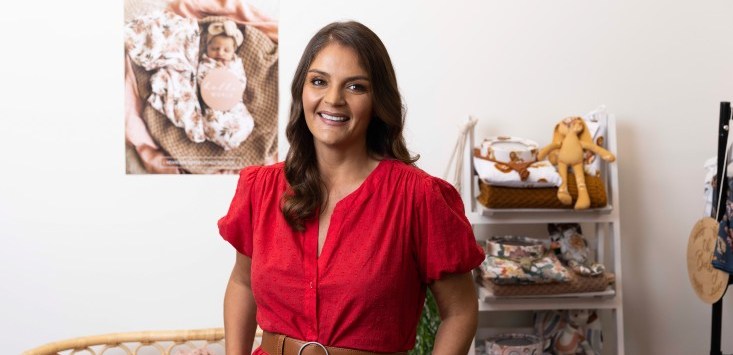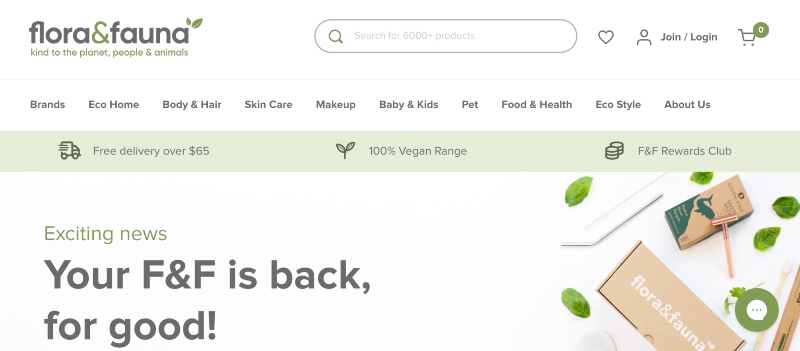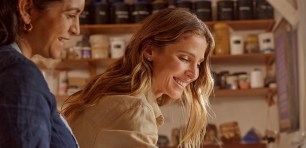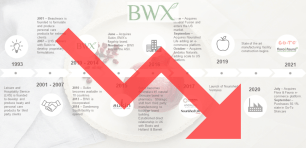
Flora & Fauna founder and Snuggle Hunny CEO Julie Mathers. Source: supplied.
Many founders could tell you about starting a successful e-commerce business. Fewer could describe restarting one.
Julie Mathers, founder of eco-conscious retailer Flora & Fauna, is among those select few. After selling the brand to beauty giant BWX for $30 million in 2021, Mathers this year partnered with fellow e-commerce experts to pluck Flora & Fauna out of BWX’s administration. The new Flora & Fauna website went live earlier this month, nine years and one day after she first launched the venture in 2014.
Long-time customers have welcomed the brand’s return, but Mathers is not naive to the ways the market for vegan, cruelty-free, and sustainable products matured in recent years. “It isn’t easy,” she said. “You’ve got to win over hearts and minds again.”
In a wide-ranging conversation with SmartCompany, Mathers described the process of founding and revitalising Flora & Fauna, how the e-commerce landscape has changed since 2014, and crucial lessons for other founders plotting their own webstore launch — from someone who’s now done it twice.

Flora & Fauna’s new website. Source: Supplied
Experience building brand
Mathers founded Flora & Fauna in 2014 to fill what she saw as a gap in the Australian market. Using “pretty terrible” website architecture costing $5,000, Mathers felt she had “nothing to lose” by turning the experience she gained through consulting in the retail sector towards her own venture. “It was quite fun, but if it didn’t work, there were no expectations,” she said.
That does not mean Mathers did not take the project seriously, describing the familiar challenges of actually finding customers and a steady roster of suppliers (on top of the unique task of proving to buyers that Flora & Fauna is not, actually, a florist). “Just building it, getting out to people, and then really defining what our personality is, always takes time,” she said.
Defining that personality was a key concern early on. Mathers describes filming no-frills and earnest product recommendations as a way of putting her passion on display, and hopefully proving to would-be buyers that the business really stood by its values. Such social media tactics are still valuable today.
On the flip side, customer feedback was also vital to shaping what Flora & Fauna eventually became. “You don’t know who you are to customers, quite frankly, until your customers tell you who you are,” she said. This humility came to serve Flora & Fauna well, both in terms of brand-building and commercial success. “Half the time our customers will tell us what they want, or they might have seen a product and suggest it to us,” Mathers added.
That approach was particularly useful when selling vegan and cruelty-free products before they had the same mainstream appeal and distribution as today. Other founders can learn from Flora & Fauna’s decision to champion products that online buyers may not have found anywhere else, which is an approach the business continues today.
“We will take on brands that others won’t even look at, and we know what is needed in the market just because we play in this space, day in and day out,” she said. “For new innovations, and the biggest range you can get, that’s why you come to F&F.”
Sincerity, receptiveness to customer feedback, and dedication to their retail niche resulted in Flora & Fauna building a dedicated community, which trusted the brand to do the hard work of identifying, stocking, and selling vegan goods.
That community, combined with Mather’s savvy understanding of the sector’s growth trajectory, helped Flora & Fauna’s annual revenue grow to $12 million across 2019-2020. The next year, the business achieved what many founders would consider a crowning achievement: a multi-million dollar buyout.
At the time, Mathers described the BWX deal as a “really exciting step” that would help the brand reach more customers and stock an even wider range of products. The next few years would be “exciting”, but perhaps not in the way she expected, providing new challenges for the seasoned e-commerce leader.
Experience rebuilding brand
BWX, which once included brands like Go-To, Sukin, and Nourished Life under its corporate umbrella, fell into voluntary administration in April this year. The ASX-listed firm listed “customer destocking and inventory and working capital issues” as contributing factors. The business’ receivers set to work offloading some BWX brands. Suddenly, the future of Flora & Fauna proved uncertain.
Enter Abel Butler and Lilani Rogers, the CEO and head of procurement and operations, respectively, of New Zealand e-commerce stalwart HealthPost. For decades, the Kiwi operation has provided ethical alternatives to consumers across the Tasman. While technically competing in similar markets, Mathers described mutual respect between herself and the HealthPost team, and the mutual exchange of kind words over social media.
When BWX collapsed, Lilani contacted Mathers with a fascinating proposal: the acquisition of Flora & Fauna, in partnership with Mathers. “When this happened, April rang me and said, ‘We’re looking at doing this, would you be interested?'”
It was not an instant ‘yes’, as Mathers was “massively busy” with Snuggle Hunny, the baby brand she acquired and assumed the CEO role of in 2022. She told the HealthPost team she would “love to be a part of it and to help, but I just can’t run it day to day. That’s where Abel and Lilani come in, and the wider HealthPost team”.
Along with Mathers’ husband Tom Abraham, Mathers teamed up with Butler and Rogers to create The Future Collective. The new venture successfully acquired Flora & Fauna, along with Nourished Life, from the BWX administration in May.
It was time to rebuild. Butler and Rogers assumed day-to-day leadership, took charge of its revitalisation, and even relocated to Australia for the venture, leaving Mathers and Abraham as “very active investors” in the new-school Flora & Fauna.
That vantage point has given Mathers the unique status of founder and re-founder, with Flora & Fauna facing a very different set of challenges in its new incarnation.
On a technical level, the refreshed Flora & Fauna site is the result of a major lift-and-shift from the Magento e-commerce platform to a new Shopify system. Physically, the enterprise required a new warehousing system. Although it is up and running, Mathers says it is still a work in progress.
“We’re very much on the journey,” she said. “So we’ve relaunched, but… it’s not like we’ve suddenly got F&F back and it’s a carbon copy of where it was before.”
“It’s difficult just starting it up again,” she added. “You can’t just suddenly go, ‘Great, here’s a thousand products’ on day one.”

Flora & Fauna’s new warehouse in Brookvale, Sydney. Source: Supplied
Mathers says the business has a six-month plan to overcome the last logistical hassles. Behind the scenes, the task of assuming control of the corporate entity itself brings its own challenges.
“When you buy a business out of administration, it is hard,” Mathers said.
To demonstrate the point, she reflected on the instant grocery delivery startup Milkrun. Once billed as a competitor to the supermarket giants, it was acquired by Woolworths in May (notably, Milkrun never technically entered administration as part of its corporate collapse). The new-look Milkrun retains the name but has lost the instant delivery ethos and mini-distribution centres which defined its first incarnation.
Maintaining Flora & Fauna’s essence while transferring its corporate ownership, and “trying to build basically the same thing again”, will take time to achieve, Mathers said. “Rome wasn’t built in a day,” she added.
Circumstances change, but the challenge remains
So, which is harder: starting out, or starting again?
“In some ways, it was much easier [starting out], as there was no expectation, and in some ways, it was harder, because we’re just starting from scratch, and we had to find our customer base,” Mathers said.
“And then relaunching was, in some ways, easier. We had a customer base already, a beautiful customer base that are on your journey, and they’re telling you what they want.
“Then, it’s actually much, much harder in other ways, because we have a website that basically doesn’t work.
“We have a lot of stock that is in a location that we need to get to a different location, and then we need to work out what’s still usable, what’s not, what has expired, all that stuff.
“And then when we started nine years ago, we didn’t necessarily have big complex processes, and we built those as we went along and as we grew. We now have to start with that. So how do you do that without overcomplicating a business?”
“So it’s so in some ways easier [today], in other ways, it’s much, much harder.”
Although the challenges have changed, Mathers said the solution is maintaining a constant, unwavering focus on what the customer actually wants.
To reflect the point, she pointed to Geedup: the red-hot apparel label whose customer base has seemingly zero crossover with Flora & Fauna fans, but whose founder Jake Paco shares the same commitment to community-building.
“Don’t copy it, because that doesn’t work,” Mathers said, referring to other e-commerce founders inspired by the Geedup story. “But try to say, ‘Okay, what are they doing, how can it relate to my business?'”
Those founders should also consider the example of Flora & Fauna, and its founder, who is helping the platform succeed in its third era.
Handpicked for you

Purely Byron wound-up after BWX collapse, as Julie Mathers scoops up Flora & Fauna, Nourished Life



COMMENTS
SmartCompany is committed to hosting lively discussions. Help us keep the conversation useful, interesting and welcoming. We aim to publish comments quickly in the interest of promoting robust conversation, but we’re a small team and we deploy filters to protect against legal risk. Occasionally your comment may be held up while it is being reviewed, but we’re working as fast as we can to keep the conversation rolling.
The SmartCompany comment section is members-only content. Please subscribe to leave a comment.
The SmartCompany comment section is members-only content. Please login to leave a comment.